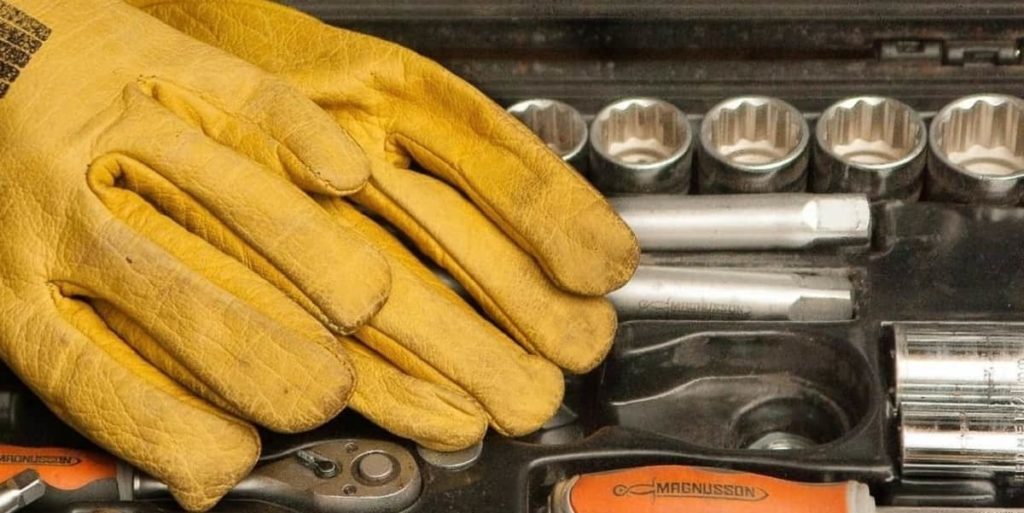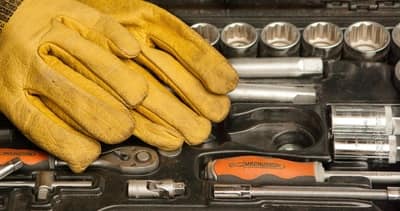Your Cub Cadet may start, but for some reason, it just isn’t moving. This can be caused by something as simple as leaving the brake on or forgetting the transmission valve was bypassed so you could push the mower.
However, parts wearing and more serious transmission problems can result in a mower that won’t move.
A Cub Cadet lawn mower won’t move or go forward when the transmission bypass lever is engaged; the pump belt is loose, worn, or broken; the tensioner pulley is worn; the spring is stretched or missing; the hydraulic oil is hot, old, or at an insufficient level; or air is trapped in the hydraulic system.
Before performing any work on your Cub Cadet, follow the safety instructions provided in your operator’s manual to prevent injury.

This post may include affiliate links. Purchases made through these links may provide a commission for us, at no extra cost to you. As an Amazon Associate, we earn from qualifying purchases.
Follow all safety instructions provided in your equipment operator’s manual prior to diagnosing, repairing, or operating.Consult a professional if you don’t have the skills, or knowledge or are not in the condition to perform the repair safely.
8 Reasons a Cub Cadet Mower Won’t Move or Go Forward
Cub Cadet Manual Transmission Bypass Lever is Not in the Operating Position
Cub Cadet hydrostatic lawn mowers use fluid in the transmission. It pumps this fluid to turn the wheels. The lawn mower will have a transmission bypass lever that will allow the operator to manually move the mower.
When the lever or bypass is engaged to manually push your mower, you must disengage the bypass once you are done moving it so your hydrostatic transmission can properly move the wheels.
You will find a couple of bypass levers on a zero-turn mower, one for each transmission (left and right). On a riding mower or lawn tractor, you will find one bypass lever located at the rear of the mower.
Cub Cadet Drive or Pump Belt is Worn, Loose or Broke
Check your Cub Cadet drive belt to make sure it hasn’t fallen off and is positioned correctly on the pulleys. If the belt appears worn, cracked, or broken, you must replace the belt.
Bad Cub Cadet Tensioner Pulley
Tensioner Pulleys are often made from hard plastic with a bearing in the center. The pulley can break or the bearing can fail on a Cub Cadet lawn mower. If you find a bad pulley, replace it with a new one. Keep the tensioner arm greased so it has some movement and does not seize up.
Worn or Missing Cub Cadet Idler Arm Spring
The purpose of the idler spring is to place tension on the drive belt. Replace the spring if it is broken, missing, or stretched.
Low Hydraulic Fluid Level or Old Hydraulic Oil in Your Cub Cadet Mower
It’s important to keep your transmission system performing at its best by regularly checking and servicing the transmission as required. Some transmission systems found in Cub Cadet riding mowers are sealed and unserviceable.
This means you cannot change the hydraulic oil. Refer to your operator’s manual to find out whether or not you are required to perform regular service on your transmission.
If your Cub Cadet mower has a serviceable transmission, consistent hydraulic oil changes at intervals recommended by Cub Cadet must be completed.
Keep in mind, the first hydraulic oil change is performed at a sooner interval than the others. Running your mower with old or low hydraulic oil can cause your lawn mower not to move or seem very weak while running.
When your hydraulic oil is low, add more hydro oil until the fluid level reaches the full level when your hydraulic oil is cool. It’s also a good idea to check for hydraulic fluid leaks to make sure your fluid level isn’t low due to a leak.
Hot Hydraulic Fluid in Your Cub Cadet Mower
When you operate your Cub Cadet lawn mower with bad hydraulic fluid or low fluid, the oil is not able to efficiently lubricate the hydraulic system causing increased friction and overheating of the hydraulic fluid. Hot hydraulic fluid can also result in more extensive damage.
I highly recommend taking the lawn mower to your local Cub Cadet dealership if you experience leaking from your hydraulic pump. If your mower runs fine when it is cold, but stops running when it gets hot, you should have an experienced mechanic check your transmission.
Air in the Hydraulic System in Your Cub Cadet Mower
After changing hydraulic fluid, you must bleed all of the air out of the system. Air in the system can prevent your mower from moving. Air can be removed from the system on most Cub Cadet lawn mowers by placing the mower on a flat surface.
Secure the front wheels using wheel chocks to prevent the mower from rolling forward. Raise the rear drive tires off of the ground and allow them to spin forward and backward until you don’t hear excessive noise and the wheels move at normal speeds.
Refer to your operator’s manual for detailed steps to remove air from your model’s hydraulic system.
Non-Transmission Related Items that Can Keep Your Cub Cadet Mower from Moving
If you don’t find the fault of your moving problem due to a transmission problem, you can check these items that can prevent the fuel and air required to run your engine.
Definitely check out these items if your engine starts to sputter or shuts off so you are no longer able to drive.
- Battery and Charging System
- Plugged Fuel Filter and Fuel Lines
- Plugged Air Filter
- Dirty Carburetor
To read more about items that can result in your mower stopping while mowing and how to fix them read my article “Reason Your Cub Cadet Starts Then Dies”.
Still Having Problems with Your Cub Cadet Mower?
If these tips haven’t solved your Cub Cadet problem or if you are experiencing a different problem with your Cub Cadet, check out my guide showing the most common Cub Cadet problems and their solutions: Common Cub Cadet Problems.
Here you’ll find the causes of Cub Cadet issues like the mower not starting, a bad cut, a vibration, or a smoking problem. I include solutions along with links to more in-depth information.
